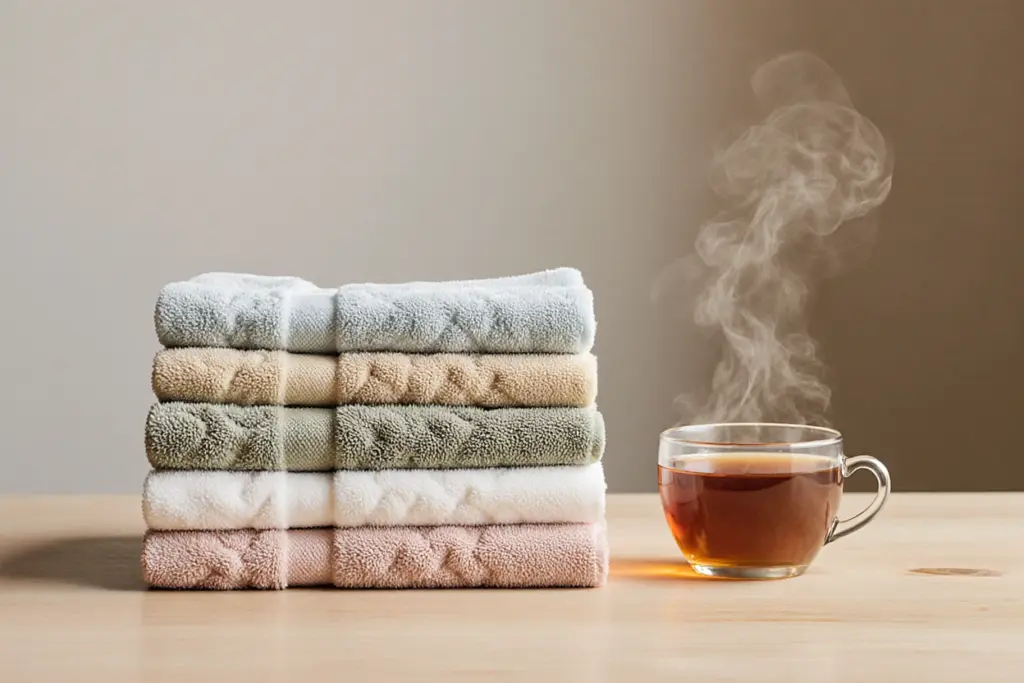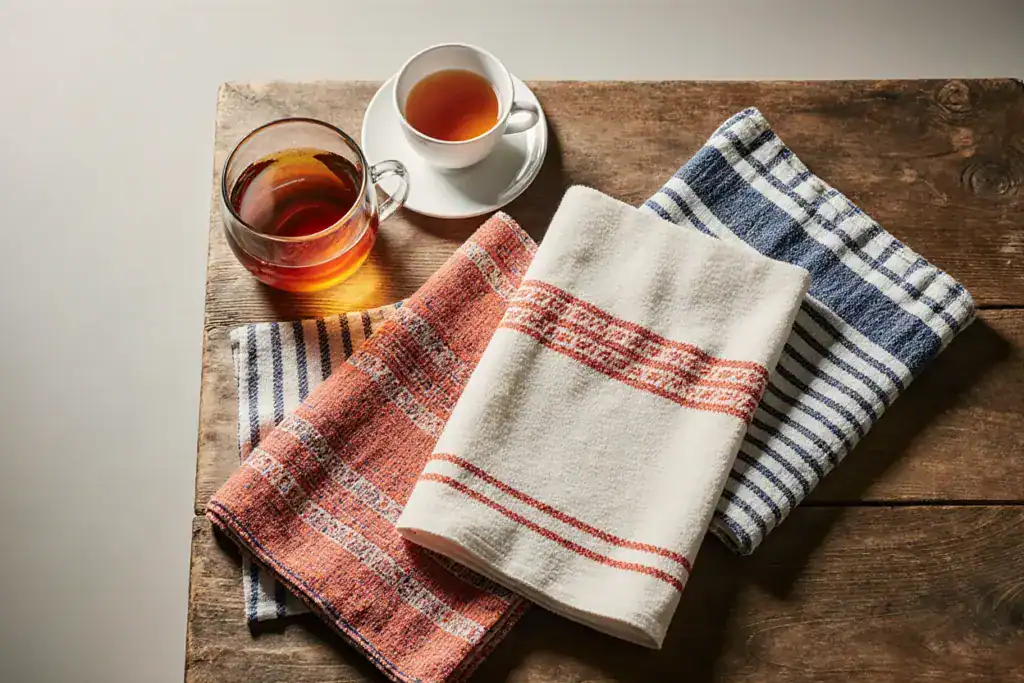Best tea towels aren’t just handy—they elevate how a kitchen looks and works, from polishing glassware to lining a bread basket or adding a pop of color to an oven handle. A thoughtfully chosen set can reduce lint on glasses, dry dishes faster, and withstand frequent washing without fading or fraying. Whether the priority is performance, aesthetics, or both, this guide breaks down materials, weaves, and real-world picks so it’s easy to choose towels that actually earn their drawer space.
Why Tea Towels Matter More Than You Think
Tea towels pull double duty as both tools and decor. A good set:
- Absorbs quickly without leaving lint on glassware
- Dries fast to avoid that musty smell
- Handles light heat tasks and quick cleanup
- Adds style through texture, color, and pattern
- Stands up to frequent washing without losing shape
Common uses include:
- Drying dishes and hands
- Polishing glass and stainless steel
- Lining bread baskets or proofing dough
- Covering rising dough or resting pasta
- Styling oven handles, hooks, and open shelving
Quick Picks (At-a-Glance)

- Best overall cotton: Soft, absorbent, and durable for daily use
- Best for glassware: Linen tea towels with minimal lint
- Fastest drying: Waffle weave with airy honeycomb texture
- Best for baking: Oversized flour sack towels for proofing and polishing
- Best eco pick: GOTS-certified organic cotton set
- Most durable: Bistro-striped restaurant-style towels
- Best decorative set: Cotton-linen prints that still perform
Buying Guide: What to Look For in Tea Towels
Choosing the right tea towels starts with understanding materials, weaves, and how they perform in a real kitchen.
Materials (Performance at a Glance)
- Cotton (flat weave): Soft and absorbent; great for everyday drying and general cleanup.
- Cotton (terry/ribbed): Plush loops soak up big spills; thicker, slower to dry.
- Linen: Naturally quick-drying, strong, and low-lint; ideal for glassware and hosting.
- Waffle weave (usually cotton): Airy honeycomb texture speeds drying and reduces odor.
- Flour sack (cotton): Thin, oversized, highly absorbent; great for bakers and polishing.
- Microfiber: Maximum absorption and quick dry; not as decorative but highly functional.
Weave, Weight, and Size
- Flat weave: Smoother surface, good for drying and wiping without snagging.
- Waffle/honeycomb: Faster airflow and evaporation; stays fresher between washes.
- Terry/ribbed: Best for heavy-duty drying, but bulkier and slower to dry.
- Lightweight vs. heavyweight: Lighter towels dry faster; heavier towels handle big jobs.
- Standard size: 16″ x 24″ to 20″ x 28″; consider oversized (up to 36″) for baking and lining trays.
Care and Longevity
- Wash before first use to remove finishes and boost absorbency.
- Avoid fabric softener and dryer sheets (they coat fibers and reduce performance).
- Use oxygen-based bleach for stain removal; sun whites to naturally lift stains.
- Tumble dry low or line dry; avoid overdrying to maintain shape and reduce shrinkage.
Comparison Table: Materials vs Performance

| Material/Weave | Absorbency | Drying Speed | Lint on Glass | Best For | Care Notes |
|---|---|---|---|---|---|
| Cotton (flat) | High | Medium | Low–Medium | Everyday drying, general cleanup | Wash warm; avoid softeners |
| Cotton (terry/ribbed) | Very high | Low | Medium | Big spills, dish-drying stations | Dry low to prevent bulk |
| Linen | Medium–High | High | Very Low | Glassware, hosting, quick turnaround | Minimal lint; line dry recommended |
| Waffle weave (cotton) | High | High | Low | Busy kitchens, humid climates | Avoid over-drying to keep texture |
| Flour sack (cotton) | High | High | Very Low | Baking, proofing, polishing | Oversized; starch-free preferred |
| Microfiber | Very High | Very High | Very Low | Heavy-duty drying, stainless steel | Wash without fabric softener |
The Best Tea Towels (Top Picks and Use Cases)
1) Classic Cotton Kitchen Towels (Best Overall)
- Why they’re great: Soft absorbency, durable stitching, and a comfortable hand-feel that improves after a few washes.
- Best for: Daily dish drying, quick hand wipes, general cleanup.
- Specs to look for: 100% cotton, flat or basket weave, reinforced hems, colorfast dyes.
- Pro tip: Choose a 6–12 pack for easy rotation so fresh towels are always on hand.
2) Premium Linen Tea Towels (Best for Glassware)
- Why they’re great: Naturally quick-drying with minimal lint, which keeps wine glasses and chrome streak-free.
- Best for: Hosting, bar carts, stemware, and polished finishes.
- Specs to look for: European flax, stonewashed finish for softness, loop for hanging.
- Pro tip: Hang linen on a hook between uses; the airflow keeps it crisp and odor-free.
3) Waffle-Weave Towels (Fastest Drying)
- Why they’re great: The honeycomb structure increases surface area for rapid absorption and evaporation.
- Best for: Busy households and humid climates where towels need to dry fast.
- Specs to look for: Medium-weight waffle (not too thin), tightly bound edges, pre-washed.
- Pro tip: If space allows, dedicate one waffle towel as a drying mat for glassware—then hang it to dry.
4) Flour Sack Towels (Best for Baking/Proofing)
- Why they’re great: Lightweight, oversized, and lint-light—perfect for covering dough or lining baskets.
- Best for: Bakers, bread baskets, polishing glass and stainless steel.
- Specs to look for: 100% cotton, unbleached or bleached depending on preference, hemmed edges, no added starch.
- Pro tip: Keep one flour sack towel just for baking to avoid scented residues from other tasks.
5) Organic Cotton Set (Best Eco Pick)
- Why they’re great: Cleaner material sourcing with solid absorbency and durability.
- Best for: Eco-minded households and those with sensitive skin.
- Specs to look for: GOTS certification, low-impact dyes, sturdy hems.
- Pro tip: Opt for neutral colors (oat, stone, white) to reduce dye wear and fading over time.
6) Bistro-Striped Restaurant Towels (Most Durable)
- Why they’re great: Tightly woven, tough cotton that’s made for high-traffic kitchens and repeated washing.
- Best for: Spill control, wiping counters, light heat handling.
- Specs to look for: Dense weave, colorfast stripe, bulk packs for value.
- Pro tip: Assign stripe colors by task—one for counters, another for dishes—to avoid cross-use.
7) Decorative Cotton-Linen Blend (Best Gift Set)
- Why they’re great: Stylish prints that still function, ideal for seasonal decor or guest-ready kitchens.
- Best for: Housewarming gifts, holiday sets, staging open shelves.
- Specs to look for: Cotton-linen blend, water-based inks, machine washable.
- Pro tip: Rotate decorative towels with core workhorses; let them shine on the oven handle.
8) Ribbed Terry Tea Towels (Best for Big Spills)
- Why they’re great: Plush loops soak up water quickly—great near the sink or dish-drying station.
- Best for: Family kitchens and heavy washing days.
- Specs to look for: Mid-weight terry, low lint rating, strong side hems.
- Pro tip: Dry on low and remove promptly to prevent stiff loops and premature wear.
9) Microfiber Drying Towels (Best Heavy-Duty)
- Why they’re great: Highly absorbent and fast drying, excellent for stainless steel and glass.
- Best for: Deep clean days, streak-free finishes, and quick turnarounds.
- Specs to look for: Tight weave, bound edges, size 16″ x 24″ or larger.
- Pro tip: Wash microfiber separately without softeners to maintain performance.
How Many Tea Towels Are Enough?
A simple framework:
- Daily rotation: 5–7 towels per active cook.
- Specialty tasks: 2 linen for glassware, 2 flour sack for baking/polishing.
- Backups: 3–4 extra for guests, holidays, or batch cooking days.
Total: 10–15 towels comfortably covers an average household with frequent cooking.
Placement and Styling Tips
- Use hooks near the sink and stove to keep towels accessible and dry.
- Mix textures: pair one linen with one cotton or waffle for form and function.
- Color strategy: choose two neutrals (white/stone/charcoal) plus one accent (sage, rust, or navy) to tie into appliances or backsplashes.
- Display decorative towels on oven handles; keep workhorse towels in drawers or on utility hooks.
Real-World Setups (Examples)
- Small apartment kitchen: 4 waffle towels + 2 linen + 2 flour sack; rely on fast-drying weaves and hang-dry overnight.
- Family kitchen: 6 cotton flat-weave + 2 terry + 2 linen; color code by task to avoid cross-contamination.
- Serious home baker: 4 flour sack + 2 linen + 2 cotton; dedicate a clean, unscented set for bread days.
Pro Tips for Performance
- Pre-wash with a little white vinegar to strip finishes and boost absorbency.
- Skip fabric softener and dryer sheets—use wool dryer balls if needed.
- Treat stains promptly with baking soda paste or oxygen bleach; sun whites to brighten naturally.
- Rotate through a designated order (glassware, dishes, counters) to keep towels fresher longer.
Table: Quick “Best For” Matching Guide
| Need | Best Choice | Why |
|---|---|---|
| Everyday dish drying | Cotton flat weave | Soft, absorbent, durable |
| Fast turnaround | Waffle weave | Dries quickly, reduces odor |
| Glassware and bar | Linen | Low lint, streak-free |
| Baking and proofing | Flour sack | Oversized, thin, highly absorbent |
| Big spills | Ribbed terry | Plush loops grab water fast |
| Heavy-duty drying | Microfiber | Maximum absorption, quick dry |
| Gift/Decor | Cotton-linen decorative | Stylish prints with function |
Care and Maintenance (Step-by-Step)
- Before first use: Wash on warm with mild detergent; add a cup of white vinegar if towels feel coated.
- After each use: Hang to dry—don’t bunch on the counter; airflow prevents odor.
- Weekly wash: Separate by color; warm water cycle; avoid softeners.
- Stain removal: Pre-treat with oxygen bleach or baking soda; avoid chlorine bleach on colored towels.
- Drying: Tumble dry low or line dry; remove promptly; reshape if needed.
- Refresh: If towels feel less absorbent, run a stripping wash with hot water, washing soda, and vinegar (separately) to remove residues.
Frequently Asked Questions
What’s the difference between tea towels and dish towels?
“Tea towel” often refers to flat-woven cotton or linen designed for drying dishes and polishing glassware, while “dish towel” can include thicker terry towels aimed at heavier drying and spill control. In practice, many households use the terms interchangeably.
Which material is best for glassware?
Linen is the go-to for stemware and mirrors because it sheds minimal lint and dries quickly, reducing streaks. Flour sack cotton is another strong option for polishing.
How many tea towels should a household keep?
For frequent cooks, plan on 10–15 total: 5–7 everyday towels, 2 specialty linen for glassware, 2 flour sack for baking, plus a few backups for guests or batch-cooking days.
Why are my tea towels leaving lint?
New cotton towels can leave lint until they’ve been washed a few times. Wash before first use, avoid fabric softeners, and consider linen or flour sack for low-lint tasks.
How do I keep towels from smelling musty?
Dry them completely between uses, switch to waffle weave or linen for faster drying, and launder more frequently in humid seasons. A vinegar rinse helps remove odor-causing residues.
Are decorative tea towels actually functional?
Yes—if they’re cotton, linen, or a cotton-linen blend with a functional weave. Reserve heavily printed towels for light tasks and use workhorse towels for drying and spills.
Can tea towels handle heat?
They can handle light heat tasks like grabbing a warm pan handle, but they’re not a replacement for oven mitts or thick pot holders.
How to Build a Balanced Tea Towel Set (Starter Bundle)
- 4–6 cotton flat-weave for everyday drying
- 2 linen for glassware and hosting
- 2 waffle weave for fast turnaround
- 2 flour sack for baking and polishing
- Optional: 2 terry for big spills, 2 microfiber for deep-clean days
This mix covers daily drying, hosting, baking, and cleanup while keeping the drawer streamlined and the kitchen looking cohesive.
Final Thoughts
The best tea towels do three things well: dry quickly, shed minimal lint, and complement the kitchen’s style. Start with a core of cotton or waffle for daily use, add linen for glassware, and finish with one decorative set to brighten up the space. With proper care and a smart mix, tea towels become one of the hardest-working—and best-looking—tools in the kitchen.

